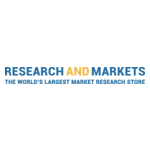DUBLIN–(BUSINESS WIRE)–The “Printed Electronic Materials Market Report – A Global and Regional Analysis: Focus on Application, End-Use Industry, Material, Technology, and Region – Analysis and Forecast, 2022-2031” report has been added to ResearchAndMarkets.com’s offering.
The global printed electronic materials market is projected to reach $17,559.59 million by 2031 from $3,454.09 million in 2021, growing at a CAGR of 18.82% during the forecast period 2022-2031.
North America and China dominated the global printed electronic materials market in 2021. North America, including major countries, such as the U.S., is the most prominent country in the market due to the presence of large automotive and consumer electronics manufacturers.
Market Lifecycle Stage
The printed electronic materials market is in the developing phase. There is rising demand for flexible displays along with increasing adoption from new end users such as automotive manufacturers and the consumer electronics industry. The automotive and transportation industry has witnessed an increase in demand for printed electronic materials due to their design flexibility, high performance, and electrophoretic properties.
Impact
Some of the factors behind the expansion of the global printed electronic materials market are increased usage for manufacturing antennas, flexible displays, soft energy devices, sensors, etc. With the rising demand for thinner electronics and wearable devices expanding, the printed electronic materials market is also expected to grow simultaneously.
Flexible electronics are involved in today’s cell phones and displays, human and health performance tools, security tags, sensor componentry in cars and airplanes, agricultural and environmental sensors, etc. With the growing adoption of smart devices, the demand for flexible electronics is increasing worldwide, which in turn may result in an increasing demand for printed electronic materials.
Further, the recent focus in the medical industry is on the development of smart cards, safe medicine packaging, smart medical wearables, and others. However, higher investment costs are hindering the printed electronic materials market growth.
Recent Developments in the global printed electronic materials market
- In January 2022, Creative Materials developed 129-32 thermoformable in-mold compatible electrically conductive ink, which has applicability in the screen-printing market. The product series has excellent adhesion capabilities to acrylonitrile butadiene styrene (ABS), polyester, poly (methyl methacrylate) (PMMA), polycarbonate (PC), and a variety of other high-energy surfaces.
- In August 2022, C3Nano announced the successful completion of a $35 million growth capital financing by Element Solutions Inc. Furthermore, the received growth capital comprised both equity and debt, enabling the company to expand its Hayward, California-based silver nanowire synthesis and production capacity.
Demand – Drivers and Limitations
The following are the demand drivers for the global printed electronic materials market:
- Growing Adoption of Printed Electronic Materials in the Automotive Industry
- Significant Cost Advantage
The market is expected to face some limitations too due to the following challenges:
- Higher Investment Cost
- Inability to Produce High-Quality Graphene on a Large Scale
Companies Mentioned
- Henkel AG & Co. KGaA
- NAGASE & CO., LTD.
- E Ink Holdings Inc.
- Agfa-Gevaert Group
- DuPont de Nemours, Inc.
- BASF SE
- Molex, LLC
- Teikoku Printing Ink Mfg. Co., Ltd.
- Creative Materials
- Poly-ink
- Sun Chemical
- ACI Materials, Inc.
- Kayaku Advanced Materials, Inc.
- C3Nano
- GenesInk
- Dycotec Materials Ltd.
- Copprint
- Mateprincs
Market Segmentation
Segmentation 1: by Application
- Display
- RFID Tag
- Photovoltaic Cell
- Battery
- Lighting
- Others
Based on applications, the displays segment dominated the printed electronic materials market in 2021 and was the largest segment due to the rising sales of smart devices across the globe. The rising demand for smartphones and flexible electronics devices is leading to the growth of the displays segment as these displays are continuously enhancing the customer experience in consumer electronics, automotive, etc.
Segmentation 2: by End-Use Industry
- Automotive and Transportation
- Consumer Electroncis
- Aerospace and Defense
- Retail and Packaging
- Healthcare
- Others
Based on the end-use industry, the automotive and transportation segment dominated the printed electronic materials market in 2021 and was the largest segment due to the rising sales of electric vehicles across the globe. The rising adoption of electric vehicles is leading to the rise in demand for printed electronic materials for lighting, display, etc.
Segmentation 3: by Material
- Ink (Silver Ink, Carbon Ink, Copper Ink, Others)
- Substrate (Organic, Inorganic)
Segmentation 4: by Technology
- Inkjet Printing
- Screen Printing
- Gravure Printing
- Flexographic Printing
- Others
Segmentation 5: by Region
- North America – U.S., Canada, and Mexico
- Europe – Germany, France, Spain, Italy, and Rest-of-Europe
- China
- U.K.
- Asia-Pacific and Japan – Japan, South Korea, India, Australia, and Rest-of-Asia-Pacific and Japan
- Rest-of-the-World – Middle East and Africa and South America
Among all regions, the North America region dominates the printed electronic materials market as it is the hub for electronics manufacturing and also comprises leading industry players across the supply chain and a fast-developing economy. Moreover, the Asia-Pacific and Japan region is growing with the fastest growth due to rapid industrialization and urbanization.
For more information about this report visit https://www.researchandmarkets.com/r/3hm9cm
Contacts
ResearchAndMarkets.com
Laura Wood, Senior Press Manager
press@researchandmarkets.com
For E.S.T Office Hours Call 1-917-300-0470
For U.S./ CAN Toll Free Call 1-800-526-8630
For GMT Office Hours Call +353-1-416-8900



